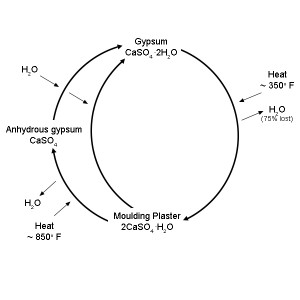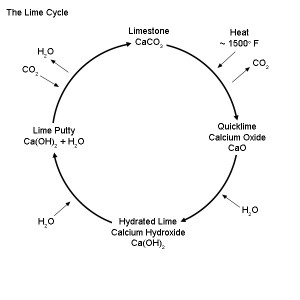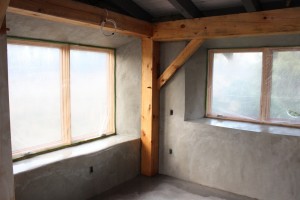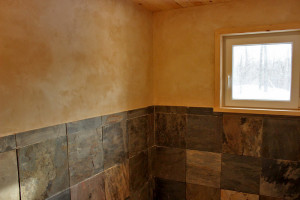In Part one of this post we looked at clay-based plasters; now we’ll examine the other natural binders, all of which are different from clay in that they have a chemical set.
Gypsum
Gypsum is one of the oldest plasters, and because it can be cooked as low as 350 degrees Fahrenheit to create a binder, it is in fact among the most ecological. Gypsum is a soft, fairly common mineral that is formed when sulphuric acid (typically from volcanoes) reacts with limestone. It is carried in solution and deposited in layers on sea-beds, and over time it forms into a soft stone which we now mine.  Chemically gypsum is hydrous calcium sulphate (CaSO4·2H2O), but when cooked at temperatures you would use to cook a casserole, three-quarters of the chemically bound water is driven off, forming 2CaSO4.H2O, which is moulding plaster (plaster of Paris), or gauging plaster – the latter is chemically identical, but is ground coarser to slow the set time. This is the most common form of gypsum plaster, and really the only one that is readily available in North America – and it cannot be used where there is any exposure to weather or moisture.
Chemically gypsum is hydrous calcium sulphate (CaSO4·2H2O), but when cooked at temperatures you would use to cook a casserole, three-quarters of the chemically bound water is driven off, forming 2CaSO4.H2O, which is moulding plaster (plaster of Paris), or gauging plaster – the latter is chemically identical, but is ground coarser to slow the set time. This is the most common form of gypsum plaster, and really the only one that is readily available in North America – and it cannot be used where there is any exposure to weather or moisture.
However if gypsum is cooked at 850 degrees Fahrenheit the remaining water is driven off and anhydrous gypsum (CaSO4) is created, which makes a very strong plaster that sets relatively slowly. Anhydrous gypsum, also called dead-burnt gypsum, can be used as an exterior plaster that lasts over 100 years, and historically it was fairly commonly used in France and Belgium.
In North America gypsum is hardly used by natural builders, however it could certainly play a greater role as an interior plaster, either on its own or mixed into earth or lime plasters. The unique properties of gypsum are very fast set time (tens of minutes to hours), and that it swells rather than shrinking as it cures. It can therefore speed up the set time of plasters, and reduce cracking, and it can be used with or without the addition of sand or fiber. Gypsum plasters also have relatively high permeability, though not as good as earth plasters. While many drywall products contain gypsum, pure gypsum plasters may need to be ordered as a specialty item, and will be sold as moulding plaster (very fast set) or gauging plaster (slower set).
Many drywall muds are best avoided, as they commonly contain toxic compounds – drywall products with a set time are usually more natural than those without. Joint compound that hardens by drying (rather than setting) contains no gypsum, and is typically rather synthetic. Drywall itself is arguably much less ecological than most gypsum plasters, because the gypsum used to manufacture drywall is usually a by-product of pollution control on coal-fired power plants. A great deal of energy is used to process this manufactured gypsum, and furthermore it may contain heavy metals or other toxins. Recycled, as well as toxin-cleaning drywall panels are available.
Lime
Lime has been used in construction for at least 9,000 years. The earliest known uses of burnt lime is in floors and plasters in the middle east; subsequently it was widely used in Greek and Roman architecture.
Today it is the most important of the natural binders for its balance of weather resistance, permeability, strength and flexibility. Lime is arguably the most perfectly balanced of the natural plasters, and it also works well in combination with the other binders.  Lime is manufactured from limestone, which is sedimentary stone created from the skeletal remains of marine organisms – simply put, from seashells accumulating and compacting over geologic time. Limestone, which has the chemical formula CaCO3, is heated in lime kilns to at least 900 degrees Celsius (1500 degrees Fahrenheit), which drives off CO2 and leaves behind highly reactive calcium oxide (CaO), or quicklime. This in turn reacts rather violently with water to form hydrated lime (Ca(OH)2), which can be either dry hydrate or lime putty, and is what we use for plastering. It gets a little more complicated because impurities in limestone can dramatically change the properties of lime used in plastering. These changes can sometimes be quite useful because they create hydraulic limes and natural cements – but more on that later.
Lime is manufactured from limestone, which is sedimentary stone created from the skeletal remains of marine organisms – simply put, from seashells accumulating and compacting over geologic time. Limestone, which has the chemical formula CaCO3, is heated in lime kilns to at least 900 degrees Celsius (1500 degrees Fahrenheit), which drives off CO2 and leaves behind highly reactive calcium oxide (CaO), or quicklime. This in turn reacts rather violently with water to form hydrated lime (Ca(OH)2), which can be either dry hydrate or lime putty, and is what we use for plastering. It gets a little more complicated because impurities in limestone can dramatically change the properties of lime used in plastering. These changes can sometimes be quite useful because they create hydraulic limes and natural cements – but more on that later.
As we mentioned, lime is a well-balanced binder. Its permeability is less than clay, but still good enough to work well with natural buildings. It is relatively strong, but still flexible enough to move with natural buildings and have fairly low cracking. The biggest downside is that it can be finicky to work with – it likes weather that is “not too hot, not too cold, but just right.” It also needs to be protected from sun and wind, and regularly misted after application for a week or more.
Hydrated lime should dry slowly over a period of days, and then it will benefit from numerous wetting and drying cycles in the following weeks, because it requires a combination of both moisture and carbon dioxide from the air in order to cure. Although it’s rare, overzealous wetting of lime plaster such that it never dries out in the first few weeks can slow carbonation and be harmful. Much more common is allowing lime plasters to dry too quickly, which also interrupts carbonation and leaves the plaster weak and chalky when carbonation does occur.
When limestone that contains impurities is burned to create lime, natural hydraulic lime (NHL) may be created. The impurities react with the lime and give it a hydraulic set, meaning it will start to set as soon as water is added even in the absence of air (hydrated lime by contrast can be mixed into a putty that will store indefinitely if it is covered with water). The advantages of the set are that natural hydraulic lime (NHL) cures in days instead of weeks, and the resulting plaster is a little harder and less porous, and can withstand freezing much sooner.
NHL 2, 3.5 or 5 are available, with NHL 5 being the most hydraulic (reactive with water), NHL 2 the least. The main disadvantages of hydraulic set are somewhat lower vapour permeability, and also the plaster is harder to work with (it is not very sticky or creamy, it feels a bit like trowelling on wet sand). Also cost – NHL is often imported from Europe. That can be a deal breaker for natural builders who believe in using local materials, but if it means breaking away from Portland cement (for late season plastering for example) that’s a big plus.
When natural hydraulic lime is hard to get locally, it can be created by adding impurities to hydrated lime. These are called pozzolans, and commonly include brick dust or other fired clay, or certain types of ash (especially volcanic ash).
Lime plasters in general tend to be somewhat porous, letting moisture in but also impeding its release more than earth plasters would. Vapour permeable paints or other sealants can be important over lime plasters, especially on fairly exposed sites. Lime also needs to be applied in relatively thin layers (3/8 inch is safe) so it may take three or more layers to level some straw bale walls.
If you’re looking for recipes for lime plasters you’ll want to get this book
Cement
Finally there’s cement, which is a dirty word in natural building circles. Natural cement occurs as a result of very specific (aluminate) impurities in lime – on the other hand, Portland cement is an artificially created cement. Natural cement can be used almost interchangeably with Portland, except that it has a very quick set time, which can be partially managed using retardants. Portland cement has higher embodied energy, contains more toxins than natural cement, but is nevertheless more widely used in plastering natural buildings because of its low cost, availability, and controlled set time. When we talk about cement, we therefore are usually referring to Portland even though it is manufactured in a way that excludes it from being a “natural” plaster.

Cement plasters are very strong, but prone to cracking, and they have low permeability. Pure Portland cement has such low permeability that it virtually guarantees rot in natural materials that it is bonded to – but when mixed at least 1:1 with lime to make a cement-lime binder, it can have limited applications in natural building, though this is controversial. On natural buildings I would almost always recommend pure lime-sand plasters over cement-lime-sand plasters. For one thing, lime has much lower cracking, therefore less maintenance and less potential for water to enter your walls. If you’re considering using portland, the minimum amount of lime is 1 lime:1 portland: 6 sand, the maximum amount of lime is 2 lime: 1 portland: 9 sand (see Building with Lime: a Practical Introduction p.121 and Essential Natural Plasters)
And Finally
Now go read Patrick Webb’s essay about blending natural binders. Special thanks to Patrick for some of the information, especially on gypsum.
Want more articles like this? Buy our book Essential Natural Plasters which has lots of info about materials, techniques, and recipes for natural plasters.


Excellent article Michael. Thank you for putting so much information into an easily understandable quick read. Hope you don’t mind if I direct customers to this article.
Errol Towers
NH Clay Plastering
Absolutely Errol. BTW here is a US source of hemp fiber for plasters http://www.hemptraders.com/product-p/f-s1.htm
I get confused by the use of the word “plaster” as both and noun and a verb. Most of us think of the noun plaster as referreing to gypsum. I am baffled by the concept of lime plaster. What kind of plaster did the Mayans use that survived for centuries in the wet jungle? What is the chemical compostion of those white beaches in Cancum? gypsum or lime? And White Sands New Mexico? I’m pretty sure that is gypsum.
I don’t understand how portland is more “unnatural” than either gypsum or lime, as they all require heating, just different temperatures. Isn’t portland simply a compound composed of clay and lime?
Hello Floyd,
I am sure Mike will get around to his own response on this, but I read your comment a few weeks ago and thought I would share my explanation.
The dominate forms of plasters in the world…now and in history, are clay first, then limes, then gypsum with blend there of being found all over the world.
Plaster, render, parge and related terms are both verb and noun depending on the syntax and focus of use.
Mayans used many different materials, but there dominate form for domestic was earth and/or lime blends. As for the beaches most are either silicate or lime (coral) unless we are speaking of the now many “man made” beaches in Cancun that have become a point of environmental contention.
As for OPC (aka portland) this material today, unlike natural cements like Rosindale’s, has become overly industrialized and of very poor quality. Roman cements and related historic geopolymers have proven to be far superior to what OPC has become today. The OPC industry is one of the heaviest environmental polluters we have in the construction industry. As for how OPC is different, it is much more highly process and must be “cooked” much more harshly and at higher temperature than the natural materials or products like natural cements.
Hope that covered most of your query…
Regards,
j
Hi Floyd, I agree with you that the distinction between natural plasters and portland cement can seem a little arbitrary. It can be said that natural plasters are dug out of the ground and burned as-is, which may result in hydrated lime, hydraulic lime, or natural cement depending on the composition of the stone and combination of impurities within it. Gypsum varies depending largely on the temperature it is burned at. On the other hand Portland is highly modified and blended, and burned at a much higher temperature than the other plasters (temperatures that only modern technology can produce). One might argue, however, that Portland is just at the far end of a spectrum. In practical terms portland behaves very differently than most of the ‘natural’ plasters, because it has extremely low permeability, high strength but also low flexibility. Portland is invaluable for building bridges, but pretty awful for plastering natural buildings, which need a very different suite of properties. One might substitute the word traditional for natural, since what we call natural plasters have all been in use for thousands of years.
Thanks to Jay for weighing in on this too.
Hey Mike,
Love this article!!!
Parts of it are almost verbatim stuff I have written, and that is a big compliment…not a complaint. I love seeing other folks with this kind of respect and knowledge of traditional and/or natural materials. When I got to the end and found reference to Patrick, I knew I was in good company. I write a great deal on natural building on Permies.com, and would love to reprint and link this article there for folks to discuss. They are a great group and one of the largest forums on natural building. If you could join in it would be all the better. May have your permission to do so?
I would love to co-facilitate something sometime. If you have a LinkedIn account can we connect there as well?
Warm Regards,
j
Absolutely Jay, reprint and link, and I will spend some time looking through permies.com – I already know I’ll love it. looking forward to more connections.
Mike